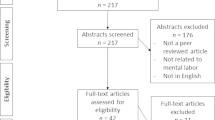Summary
A logit technique is used to estimate couples' joint probabilities of various labor force statuses, given their personal characteristics. Conditional probabilities of the labor force status of wives are inferred. Women whose husbands face employment constraints are compared with counterparts whose husbands face no employment constraints. The results tend to confirm an added-worker effect, especially among women whose husbands are unemployed.
Similar content being viewed by others
References
Amemiya, T. (1981), ‘Qualitative Response Models: A Survey,’Journal of Economic Literature, 19, pp. 1483–1536.
Blank, R. (1988), ‘Women's Paid Work, Household Income, and Household Well-Being,’ in: S. Rix (ed.),The American Women 1988-89: A Status Report, New York, W.W. Norton, pp. 123–161.
Clain, S. and K. Leppel (1994), ‘A Note on the Economic Analysis of the Labor Force Status of Married Couples,’Pennsylvania Economic Review, 4, pp. 39–50.
Cramer, J.S. and G. Ridder (1991), ‘Pooling States in the Multinomial Logit Model,’Journal of Econometrics, 47, pp. 267–272.
Heckman, J.J. and T.E. MaCurdy (1980), ‘A Life Cycle Model of Female Labor Supply,’Review of Economic Studies, 47, pp. 47–74.
Layard, R., M. Barton and A. Zabalza (1980), ‘Married Women's Participation and Hours,’Economica, 47, pp. 51–72.
Leppel, K. and S. Clain (1993), ‘Determinants of Voluntary and Involuntary Part-time Employment,’Eastern Economic Journal, 19, pp. 59–70.
Lundberg, S. (1985), ‘The Added Worker Effect,’Journal of Labor Economics, 3, pp. 11–37.
Lundberg, S. (1988), ‘Labor Supply of Husbands and Wives: A Simultaneous Equations Approach,’Review of Economics and Statistics, 70, pp. 224–235.
Maloney, T. (1987), ‘Employment Constraints and the Labor Supply of Married Women: A Reexamination of the Added Worker Effect,’Journal of Human Resources, 22, pp. 51–61.
Maloney, T. (1991), ‘Unobserved Variables and the Elusive Added Worker Effect,’Economca, 58, pp. 173–187.
Mincer, J. (1962), ‘Labor Force Participation of Married Women: A Study of Labor Supply,’ in: H.G. Lewis (ed.),Aspects of Labor Economics, Princeton, N.J., Princeton University Press, pp. 63–105.
Wales, T. and A. Woodland (1976), ‘Estimation of Household Utility Functions and Labor Supply Response,’International Economic Review, 17, pp. 397–410.
Additional information
The authors aro Assistant Professor at Villanova University in Villanova, PA, and Associate Professor at Widener University in Chester, PA, respectively, and are equally responsible for the contents of this paper.
Rights and permissions
About this article
Cite this article
Clain, S.H., Leppel, K. Further evidence of the added-worker effect among white couples. De Economist 144, 473–486 (1996). https://doi.org/10.1007/BF01682837
Issue Date:
DOI: https://doi.org/10.1007/BF01682837




